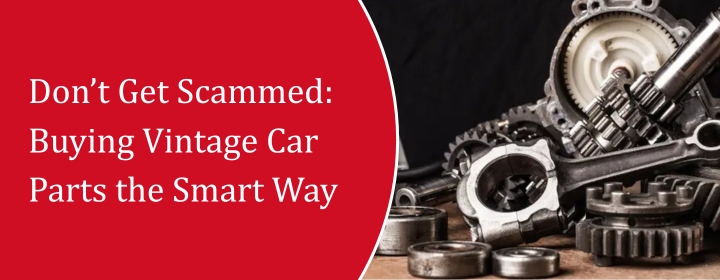
Don’t Get Scammed: Buying Vintage Car Parts the Smart Way
There is something unique about old cars which feel different. Its curves, chrome, engine sound. But here is the thing: keeping a vintage car alive isn’t easy. Its parts are rare, expensive, and the market’s crawling with scammers trying to make a quick buck off your passion. If you’ve ever been burned by a shady seller or waited months for a part that never showed, you know exactly what does it means. Let’s be real, buying vintage car parts online feels like rolling the dice. You’re trying to search something that might’ve been discontinued decades ago and half the listings out there either look too good to be true or price is high. If you stay alert then you can find real deals and authentic parts, without draining your wallet. Here in this guide, we will discuss how you can buy vintage car parts. the smart way without getting scammed.
Tips to Buy Vintage Car Parts
1.Start with Research, Not Impulse — Especially for Vintage Car Parts
First rule: slow down. We know the feeling when you finally find that rare engine or transmission, you’ve been searching for. It’s feels like striking a goldmine. But don’t click on ‘buy now’ too fast. That’s exactly how scammers get you.
Start by cross-checking part numbers. Every genuine vintage car part has one, whether it’s stamped on metal or on an old catalog. Look it up in official parts diagrams or forums dedicated to your car model. There are a ton of online communities, people who’ve been restoring these cars for decades. Ask them. Half the time, they’ll even tell you which sellers to trust and which ones to avoid.
If a listing doesn’t have clear photos of the part number or the condition, that’s a red flag. No exceptions. Real sellers like beelinesautomotive.com know that buyers want proof.
2. Check the Vintage Car Parts Seller’s History
You’d be surprised how many new sellers comes on eBay or marketplace sites every week just to scam people once or twice before disappearing. Always dig into their history.
If you’re on eBay, check their rating and read the actual reviews. Sometimes they have five stars but all from selling something else and not vintage car parts. Not the same thing. You want someone who’s been around, sold used engines or vintage car parts before, and has photos that look like they actually took them, not stock images pulled off Google.
Also, don’t hesitate to ask questions. Ask different questions from the seller to know whether they are genuine and sells what they claim. Scammers generally give generic and vague replies or avoid it.
3. Photos Tell the Truth and Vintage Car Parts Condition
The photos are everything. If the pictures look too perfect, crisp, and polished, you need to be careful. Most of the legit sellers like beelinesautomotive.com are working out of a garage, not a studio. A few oil stains and dust actually make it more believable.
Look for consistency. If there is same background, same lighting in all shots then that is good. Random images look like they came from different a place which is a bad sign.
Zoom in the photos and check for wear, scratches, and leaks. These things tell that it’s real and not just freshly painted junk. A part which is 40 years old doesn’t supposed to look brand-new unless it has been rebuilt which seller should clearly mention.
4. Price Isn’t Everything
People often assume that a higher price means authenticity which is not. Sometimes scammers bank on that logic. They’ll post a rare part at a ‘premium’ price just to look more legit.
Before you spending big investment, you need to check what similar parts are worth for. Search across multiple sites like specialty forums, Craigslist, eBay, Facebook groups, and online websites like beelinesautomotive.com. There is usually a price range which feels right. If something is way above or below then you should be suspicious.
When it comes to used engines for sale, pricing research is even more important. Engines can vary wildly depending on mileage, compression, and rebuild history. Always ask for compression test results or at least a short video of it running before purchase. If a seller refuses that, walk away.
5. Always Trust Your Gut
If you felt something doesn’t right then it probably isn’t. The seller can be extremely pushy, the pictures might not appear right, or they might not be willing to use a secure payment method. No matter what the cause is, don’t ignore your gut feelings.
You have to be patient to find a real and reliable vintage vehicle part. It takes time and looking at listings every day. But when you eventually get the real part that fits precisely and brings your vehicle back to life, you’ll know it was all worth it.
Follow these tips to save your investment from scammers when searching for vintage car parts.
Conclusion
In short, we can say that buying vintage car parts isn’t just about money. It is also to protect your passion by getting a reliable part. Scammers scam those people who are in hurry to finalize the deal. Don’t give them that chance. You must do your homework, verify everything, and always think twice before making a payment. There will be your part out there, you just need to shop smart, stay patient, and knows what you are looking for. Whether it is a trim, transmission, or used engines for sale.